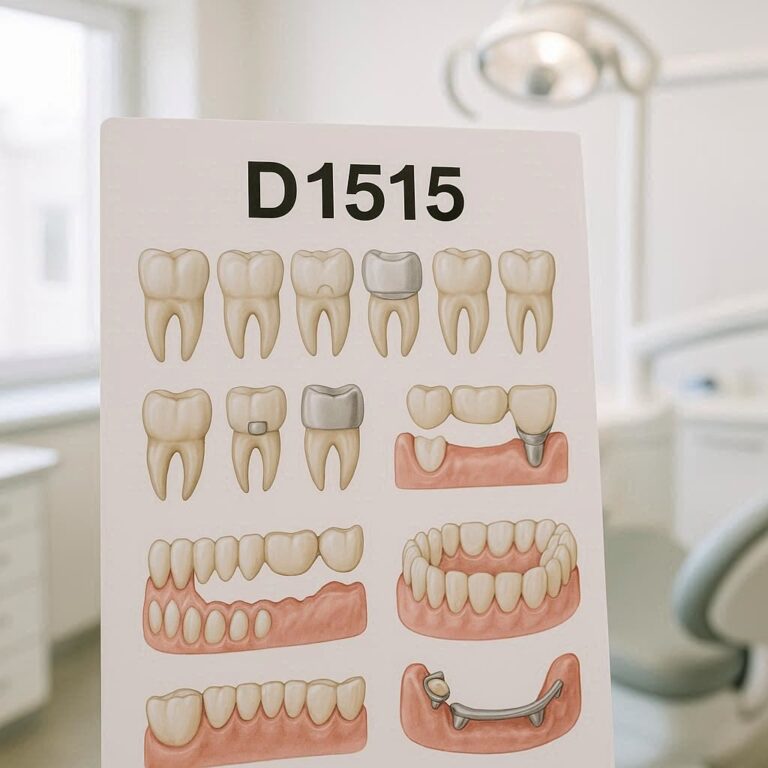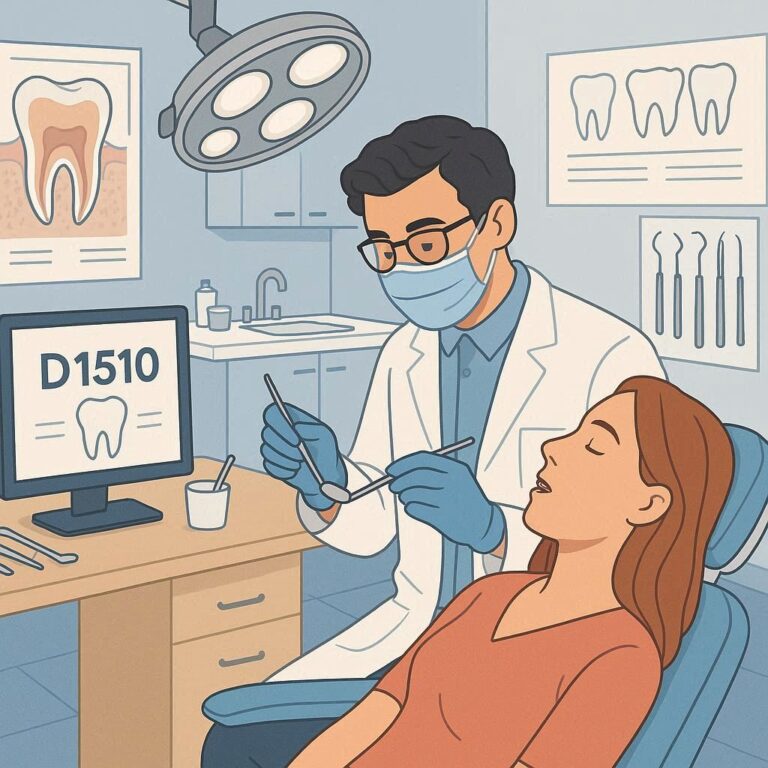What Does Dental Code D6057 Mean?
Dental codes are essential in the field of dentistry, serving as standardized methods for describing dental procedures and services. Among these, dental code D6057 plays a crucial role in specific dental treatments, particularly related to dental implants. This article delves deep into what dental code D6057 signifies, its applications, and its implications for both dental professionals and patients. By understanding this code, patients can better navigate their dental care options, and professionals can ensure accurate billing and treatment planning.

Understanding Dental Code D6057
Dental code D6057 refers to a “custom-fabricated abutment,” a critical component in dental implant procedures. An abutment is a connector placed on the top of a dental implant, serving as the foundation upon which a dental crown or bridge is mounted. This code specifically applies to abutments that are custom-made, rather than prefabricated, ensuring a precise fit for the patient’s implant.
- Definition: D6057 is defined as a custom-fabricated abutment designed to support a dental prosthesis (such as a crown or bridge) on an implant. The custom nature of this abutment allows for a more accurate fit and better aesthetic results compared to prefabricated options.
- Purpose: The custom-fabricated abutment under D6057 is used when a standard abutment cannot achieve the desired result, either due to the unique anatomical structure of the patient’s mouth or specific aesthetic considerations.
The Role of Custom-Fabricated Abutments in Dental Implants
Custom-fabricated abutments are designed to address various clinical scenarios where a standard, prefabricated abutment may not suffice. These abutments are created based on the exact specifications of the patient’s dental implant and surrounding tissues, ensuring a snug fit and optimal support for the prosthetic crown.
- Precision and Fit: One of the primary advantages of a custom-fabricated abutment is the level of precision it offers. These abutments are tailored to the specific dimensions of the implant and the patient’s gum line, providing a better fit and reducing the risk of complications such as gum irritation or implant failure.
- Aesthetics: Custom abutments are often preferred in cases where the appearance of the implant is critical, such as in the front teeth. The custom design allows for better control over the final look of the prosthesis, ensuring it matches the patient’s natural teeth in color, shape, and size.
- Longevity: By offering a better fit and greater stability, custom-fabricated abutments can contribute to the long-term success of the dental implant, reducing the likelihood of issues that could lead to implant failure or the need for further corrective procedures.
The Process of Creating a Custom-Fabricated Abutment (D6057)
The creation of a custom-fabricated abutment involves several detailed steps, each crucial to ensuring the final product meets the specific needs of the patient. Here is an overview of the process:
- Initial Assessment: The dentist evaluates the patient’s mouth, focusing on the placement of the dental implant and the surrounding tissues. This assessment helps determine whether a custom-fabricated abutment is necessary.
- Impression Taking: An impression of the patient’s mouth is taken, either using traditional dental molds or digital scanning technology. This impression captures the exact contours of the implant site and adjacent teeth.
- Design and Fabrication: The impression is sent to a dental laboratory, where technicians use advanced software to design the abutment. The design is then used to fabricate the abutment from materials such as titanium or zirconia, chosen for their strength and biocompatibility.
- Fitting and Adjustment: Once the custom abutment is fabricated, it is fitted onto the implant. The dentist may make minor adjustments to ensure a perfect fit before attaching the final prosthesis.
- Final Placement: After ensuring the custom abutment is securely fitted, the prosthetic crown or bridge is placed, completing the dental restoration.
Advantages of Using Dental Code D6057
Custom-fabricated abutments coded under D6057 offer numerous benefits for both patients and dental practitioners. These include:
- Improved Patient Comfort: Custom abutments are designed to fit the patient’s unique oral anatomy, reducing discomfort and improving overall satisfaction with the implant.
- Enhanced Aesthetics: The custom nature of these abutments allows for a seamless blend with natural teeth, which is especially important in visible areas of the mouth.
- Increased Durability: Custom-fabricated abutments tend to be more durable and better suited to withstand the forces of chewing, contributing to the longevity of the implant.
- Better Tissue Integration: By closely matching the contours of the surrounding tissues, custom abutments can promote better gum health and reduce the risk of gum recession around the implant.
Cost Considerations for D6057
The cost of a custom-fabricated abutment can vary depending on several factors, including the materials used, the complexity of the case, and the geographical location of the dental practice. Generally, custom-fabricated abutments are more expensive than prefabricated ones due to the specialized nature of their production.
- Material Costs: The choice of material (titanium, zirconia, etc.) can significantly impact the overall cost. Zirconia, for instance, is often more expensive due to its superior aesthetic properties and strength.
- Laboratory Fees: The process of designing and fabricating a custom abutment involves skilled labor and advanced technology, which can contribute to higher laboratory fees.
- Insurance Coverage: Not all dental insurance plans cover the full cost of custom-fabricated abutments. Patients may need to check with their insurance provider to understand their coverage and potential out-of-pocket expenses.
Cost Comparison Between Custom-Fabricated and Prefabricated Abutments
| Aspect | Custom-Fabricated Abutment (D6057) | Prefabricated Abutment |
|---|---|---|
| Cost | Higher | Lower |
| Aesthetic Results | Superior | Standard |
| Fit and Precision | Highly Accurate | Less Accurate |
| Durability | More Durable | Standard |
| Material Options | Titanium, Zirconia | Limited |
| Insurance Coverage | Varies | More Likely Covered |
FAQs
- What is the difference between a custom-fabricated abutment and a prefabricated abutment?
- Custom-fabricated abutments are designed specifically for an individual’s dental implant, ensuring a precise fit and better aesthetics, while prefabricated abutments are standardized components that may not fit as perfectly.
- Why is dental code D6057 used?
- Dental code D6057 is used to identify the procedure of creating and placing a custom-fabricated abutment, which is often necessary when a prefabricated abutment does not meet the patient’s needs.
- Are custom-fabricated abutments more expensive than prefabricated ones?
- Yes, custom-fabricated abutments generally cost more due to the personalized design and fabrication process, as well as the use of high-quality materials.
- Does insurance cover the cost of a custom-fabricated abutment?
- Coverage varies by insurance plan. Patients should consult with their provider to determine the extent of their coverage for custom-fabricated abutments.
- How long does a custom-fabricated abutment last?
- With proper care, a custom-fabricated abutment can last many years, often matching the lifespan of the dental implant itself.
Conclusion
Dental code D6057, which refers to the use of a custom-fabricated abutment, is a vital component in dental implantology, offering patients a tailored solution for their dental restoration needs. This code ensures that the abutment used is specifically designed to fit the patient’s implant and surrounding tissues, providing superior aesthetics, comfort, and durability. Understanding this code helps patients make informed decisions about their dental care and ensures that dental professionals can deliver the highest standard of treatment.
Additional Resources
- Dental Economics: The Importance of Custom Abutments in Implant Dentistry
- PubMed: Comparative Study on the Effectiveness of Custom-Fabricated vs. Prefabricated Abutments


